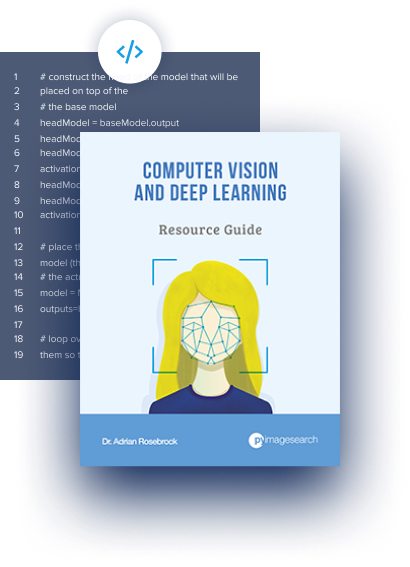Wow, the IndieGoGo launch date of Wednesday, August 19th is approaching so fast!
I still have a ton of work left to do and I’m currently neck-deep in IndieGoGo campaign logistics, but I took a few minutes and recorded this sneak peak preview of OCR with OpenCV, Tesseract, and Python:
The video is just under six minutes and covers all the details on the IndieGoGo campaign — I recommend you watch the video overview if you have any interest in this OCR book.
That said, I understand and respect that you’re busy and might not have the time to watch the video, so I’ve included the high-level bullet points below:
- 0m15s: OCR is a simple concept — we take an input image, automatically recognize the text in the image, and then convert it to a machine-encoded variable
- 0m30s: But despite being such an intuitive concept, OCR is extremely challenging. The field of CV has existed for over 50 years but we still have not solved OCR
- 0m45s: Trying to code custom OCR software is near impossible. And utilizing OCR engines such as Tesseract can be challenging if you don’t know which knobs and dials to tune
- 1m20s: Deep learning is responsible for unprecedented accuracy in computer vision — but which models, layer types, and loss functions do you use for OCR?
- 2m00s: This book will teach you how to successfully (and confidently) apply OCR to your work, research, and projects
- 2m15s: I discuss and demo the OCR projects you will learn inside the text, including OCR basics, text detection, automatically OCR’ing documents/forms, training custom OCR models with Tesseract, ANPR, handwriting recognition, OCR in video, and more!
- 3m40s: Since this book covers such a large amount of content, I’ve decided to break the book down into three volumes, called “bundles”. You’ll be able to choose a bundle based on how in-depth you want to study OCR, which projects/chapters interest you the most, along with your particular budget.
- 4m10s: I show what chapters are included in each bundle.
- 5m47s: OCR is extremely hard, but my new book un-weaves all the complexity for you and gives you a clear, easy to follow path to successfully apply OCR to your own work.
How you educate yourself defines your character.
This past Saturday morning I finished reading Erik Larson’s Issac’s Storm, the true story of how a powerful hurricane absolutely destroyed the town of Galveston, Texas in 1900.
This storm is considered to be deadliest hurricane in United States history, not just because of the storm’s raw power, but because of man’s arrogance at the turn of the century — forecasters believed that they could not only predict the weather, but control it as well.
Mother nature has a way of knocking us down a few pegs and keeping our hubris in check.
One of my favorite quotes from the book is where Larson paraphrases Hippocrates, a prominent Greek physician who lived around 400 BC:
Hippocrates believed climate determined the character of men and nations.
It makes sense if you think about it.
- If the weather is too hot, your fields can’t grow
- If it’s too cold, your your crops will freeze and die
- If it rains too much, your town will flood
- And if it’s too windy, your house will blow over
It’s hard to build a great nation when the weather prevents you from finding food, shelter, or employment!
However, I personally believe it’s education, not climate, that determines the character of men and nations.
- Education is how we grow, not only as individuals, but collectively as well.
- Exposing ourselves to new concepts opens our minds and makes us more accepting of things we didn’t previously understand or couldn’t relate to
- Education requires a level of discipline, and within that discipline we build character
- The final product of routine daily education is enlightenment — and it takes enlightened people to build a strong nation
I have a passion for education. Every day I allocate one hour to educating myself on a topic I don’t know much about. I then spend the rest of the day educating PyImageSearch readers (such as yourself), teaching them how to successfully apply computer vision, deep learning, and OpenCV to their own projects.
Now, I’ll be teaching Optical Character Recognition. I hope you’ll consider grabbing a copy of my new book next week (or, at the very least, spend some time educating yourself on a new topic — education defines your character after all).
What’s next?
Like I said, if you have the time, the sneak preview video is definitely worth the watch. The video goes into more depth than what I can in this email, explaining what’s covered in the book and how it’s organized.
I hope that you decide to support the OCR with OpenCV, Tesseract, and Python IndieGoGo campaign on Wednesday, August 19th at 10AM EDT — if you’re ready to learn how to successfully apply OCR to your projects, then this is the perfect book for you!
To be notified when more IndieGoGo announcements go live (including ones I won’t be publishing on this blog), be sure to signup for the OCR with OpenCV, Tesseract, and Python notification list!

Join the PyImageSearch Newsletter and Grab My FREE 17-page Resource Guide PDF
Enter your email address below to join the PyImageSearch Newsletter and download my FREE 17-page Resource Guide PDF on Computer Vision, OpenCV, and Deep Learning.
The post Sneak preview: OCR with OpenCV, Tesseract, and Python appeared first on PyImageSearch.